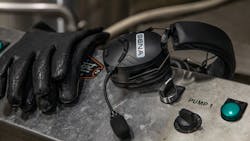Modern communication technology improves productivity for modern processing facilities
Today’s processing facilities have technology implemented at a variety of levels to improve efficiency and productivity, from IoT-connected machinery to software-driven automation process. One area of technology where even many smart plants fall behind is team communication.
There is a myriad of communication challenges for onsite personnel in processing facilities. Typically, person-to-person communication in plants has been implemented using two-way radios, which were originally developed in the 80s and are still broadly used in processing facilities today. Two-way radios draw out what would otherwise be quick conversations with extra steps for each person involved, such as having to take their turn speaking and needing to have a hand free to use the radio, not to mention that some personnel have to carry multiple different radios to communicate with different teams within the facility. Interference with PPE was an issue in some plants, specifically when team members had to pull down their masks to use the radio.
Some facilities maintain a no-technology method of person-to-person communication, relying on face-to-face communication and the “go find them” approach, at times resorting to using an employee’s personal or company-provided cell phone to reach them. The problems with this lack of technology use are apparent and range from general inefficiency to negatively impacting employees’ health and wellbeing. When communicating without technology in loud environments, shouting has led to employees developing laryngitis, errors in messaging as well as just plain poor communication habits. Social distancing practices further exacerbate the challenges of in-person communication.
With current COVID requirements for masks and physical distance between employees, communication via old technology like two-way radios, or no technology via the “shouting” method, is simply not practical.
Modern processing facilities require modern communication technology. There are many communication technology solutions available, and two that should be considered are Bluetooth Intercom and Mesh Intercom systems.
Modern communication technology solutions
The purpose of communication technology systems in processing plants should be to improve workers’ day-to-day communication and enable them to work safely, effectively and efficiently with the entire team. To accomplish that, the technology must be robust and reliable. Both Bluetooth and Mesh technologies are easy to implement onsite, often without even needing support from IT.
Bluetooth
One solution is the deployment of Bluetooth headsets for personnel. The commonly held perception of Bluetooth devices is often that they are short-range accessories. The word “Bluetooth” itself elicits mental images of pairing earbuds to a smartphone for phone calls or of setting up a wireless speaker to listen to music in the backyard. These perceptions are not accurate when it comes to industrial-grade Bluetooth communication devices.
Industrial-grade Bluetooth offers wireless communication technology that connects electronic devices, in this case headsets, together using short-wavelength radio waves. Available solutions will allow paired connections between up to four devices. In addition to easy wireless connection from headset to headset, a Bluetooth Intercom solution can offer full duplex communication and hands-free operation. Short-wave does not necessarily mean short-range, industrial-grade Bluetooth can provide connection ranges compatible with the size of most processing facilities.
Bluetooth Intercom devices require peer-to-peer pairing for each device used by a team of up to four people. Once paired, Bluetooth headsets will reconnect to other headsets when brought into range (consider an employee taking their company-issued headset home at the end of the workday and then returning to work the next morning.)
Mesh Intercom
Although Bluetooth headsets offer a good solution to processing facility communication needs, Mesh Intercom devices provide an even more robust solution, especially for demanding applications and teams larger than four people. Mesh networks use local network topology with an infrastructure of nodes, or headsets, that connect directly to many other nodes without hierarchy. This means that data or signals can be routed in the most effective manner possible. In short, each headset on the network builds the network and can act as a relay. The more headsets on the Mesh Intercom network, the stronger and larger it will be. Unlike Bluetooth Intercom networks that are limited to four connections per team, Mesh Intercom networks are virtually limitless in the number of connections they can support.
Mesh networks are not new technology. Mesh Intercom systems have been proven in a variety of other industries and have now made their way to the industrial processing market. Mesh Intercom is a dynamic communication system built on a mesh network that provides reliable, instant and effortless peer-to-peer communication without the pre-grouping process required by Bluetooth Intercom. Mesh Intercom users can connect and communicate with other users in the network’s large range by simply turning on their headset and they will not have to reconnect their headset to the network if they go out of range.
Mesh Intercom and Bluetooth Intercom systems can be completely independent from other plant networks. They do not require Wi-Fi or cellular signals to operate. Provided the connected headsets are charged, the systems can also be used without access to electricity, repeaters or separate antenna.
Solving communication challenges with Bluetooth and Mesh solutions
Full duplex and high-quality sound
Traditional two-way radios do not offer duplex communication, therefore only one user may speak at a time by pressing a button. This forces unnatural conversation structure and lengthens the time it takes for messages to be sent, received and confirmed among teams. Full duplex communication provided by both Bluetooth and Mesh devices allow workers to speak with each other in a more natural conversational manner. Full duplex, combined with hands-free operation, significantly speeds up communication, enabling workers to focus more on completing the tasks at hand rather than talking about them.
In addition to the benefits of full duplex, devices operating with Bluetooth or Mesh provide higher quality sound than two-way radios. Because of the strength and quality of connection with these two intercom technologies, users can hear each other clearly in high definition. Bluetooth and Mesh intercom systems are not susceptible to the pops, crackles and other sound quality issues common with two-way radios.
Multiple channels
Mesh networks allow for a single communication device to work on different channels for better communication with every group on the plant floor. This enables easy communication with engineering, maintenance, supervisors and even training groups. The ability to use multiple channels on a single device simplifies communication by eliminating the need for personnel to manage multiple devices and improves productivity.
Adherence to health and safety requirements
Bluetooth and Mesh Intercom headsets enable safer operations and adherence to cleanliness standards in a variety of ways. For sanitary applications such as food and beverage or pharmaceutical processing, cleanliness is paramount. Headsets may be easily integrated with PPE. They may be worn inside suits for clean rooms and microphones may be used inside of masks. Wireless headsets mean there is no more pulling off a mask or gloves to use a two-way radio or attempting to decipher speech muffled by a protective mask.
These platforms also offer significant mix-and-match capabilities for headset styles for different work zones. For example, personnel in loud environments may be outfitted with combination noise-attenuating earmuff headsets, whereas a standard over-the-ear headset without hearing protection may be sufficient for someone working in a lab or shipping. Mesh Intercom adapters can also be provided to connect standard consumer Bluetooth headsets, such as AirPods, to the Mesh communication network for on-site guests or could be used for office workers to bring their own devices and still communicate.
Integration with Industry 4.0
For facilities that operate with Industry 4.0 practices and integrate IoT devices, Mesh Intercom systems can further integrate into the smart plant environment. In addition to, or in place of, warning lights or text-based alerts, machines that have Bluetooth-enabled PLCs can also be adapted for auditory alerts for those using headsets on the Mesh Intercom network. This speeds up error recognition and resolution.
Adapting to the new normal
These modern communication technologies enable a significant amount of flexibility to accommodate the “new normal” while avoiding reductions in productivity.
Personnel can continue to maintain proper physical distance from others while having a normal conversation – no yelling required – with their teammates. Additionally, individual employee-dedicated headsets may be deployed, helping plants continue to avoid shared personal equipment. Multiple channels within a Mesh Intercom system can also eliminate the need for plant managers to have a separate device for each team.
Real-world applications
For one large-scale food producer, Mesh Intercom technology saved the day when pandemic-related travel restrictions made an important machine training demonstration impossible to do in person. Executives were originally supposed to fly out to visit the plant for an on-site machine training. When travel restrictions came into effect, the trip was canceled. Instead, they were able to set up a video call on an iPad paired to the Mesh Intercom network using Sena’s MeshPort Red adapter. By combining the video conference technology with the Mesh Intercom system, the executives could see the machine and talk with the five individuals who were on site using Sena’s TuffTalk M headsets to maintain appropriate distance from each other. The company continues to use Sena products to keep employees safe during production and extend training remotely.
A beverage production company had adopted Mesh Intercom for its communication system. The technology was not only useful for daily productivity and efficiency, but when an earthquake near their plant in Central America knocked out power and other communication networks, their team was able to stay connected. Since the Mesh Intercom does not rely on electricity, antenna, Wi-Fi or cellular signal, the earthquake did not disrupt communication. The plant’s team was able to check on each other and assess the situation without skipping a beat.
The human element
The “human element” in processing has the potential to make the largest impact on productivity. By equipping personnel with modern technologies that incorporate Bluetooth or Mesh Intercom for communication systems they can focus on being productive and efficient, they can collaborate in a safe manner and will be able to communicate to do their work, rather than stop their work to communicate.
Chris Clarke is director of global sales at Sena Technologies. Established in 1998, Sena Technologies is a global leader in Bluetooth communication innovations and created the Mesh Intercom system. Sena offers Bluetooth and Mesh enabled headsets and communications solutions that provide safe, handsfree communication, reliability and efficiency for a host of industrial and outdoor worksite environments.
About the Author
Chris Clarke
Director of Global Sales, Sena Technologies
Chris Clarke is Director of Global Sales for Sena Technologies


